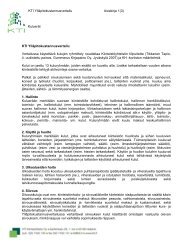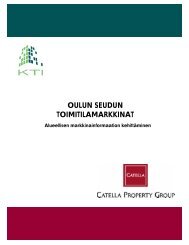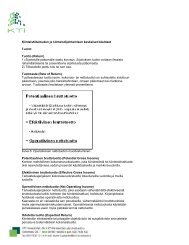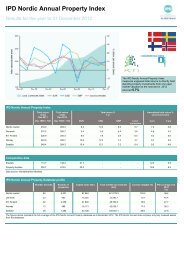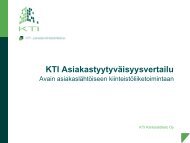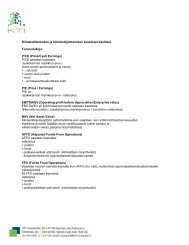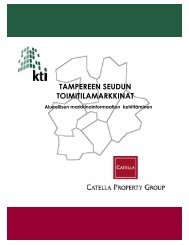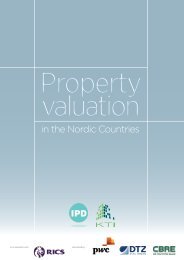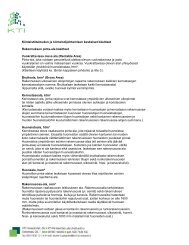The Finnish Property Market 2012 - KTI
The Finnish Property Market 2012 - KTI
The Finnish Property Market 2012 - KTI
You also want an ePaper? Increase the reach of your titles
YUMPU automatically turns print PDFs into web optimized ePapers that Google loves.
30<br />
<strong>The</strong> <strong>Finnish</strong> <strong>Property</strong> <strong>Market</strong> <strong>2012</strong><br />
in early <strong>2012</strong>, will create increasing challenges for Senate<br />
properties in the coming few years.<br />
<strong>The</strong> majority of the <strong>Finnish</strong> university properties<br />
are currently owned by three limited companies, which<br />
were founded in 2010 for the sole purpose of owning and<br />
managing university buildings. Two of the companies own<br />
and manage university buildings in the Helsinki metropolitan<br />
area (Helsinki University Properties and Aalto University<br />
Properties), and one elsewhere in Finland (University<br />
Properties of Finland ltd). Universities own a two-third’s<br />
majority of the shares of these companies, with the state<br />
owning the remaining third.<br />
“Public sector’s<br />
property management<br />
facing increasing<br />
challenges”<br />
<strong>Finnish</strong> municipalities are typically highly significant players<br />
in regional markets and own the majority of properties<br />
required for public administration and service provision, such<br />
as offices, schools, nurseries and healthcare centres, as well<br />
as cultural buildings. It is estimated they currently own some<br />
90% of all premises they use. Some municipalities, such as the<br />
City of Helsinki, in particular, also have significant amount<br />
of space that it lets to private market players. Real estate<br />
management has gone through considerable development in<br />
most municipalities in recent years.<br />
All major municipalities have centralised their real estate<br />
management functions and tend to apply a market-oriented<br />
management policy; for instance, by charging internal rents<br />
from the occupiers. Municipalities’ property ownership<br />
and management are facing considerable challenges due<br />
to the tight financial situation. In the future, potential<br />
significant changes in the municipal structure and/or service<br />
provision strategies will also have an impact on the need and<br />
management of properties.<br />
Corporations<br />
Traditionally, property occupiers have played a significant<br />
role in the <strong>Finnish</strong> property market through their ownership<br />
of large property portfolios. <strong>The</strong> majority of commercial<br />
property stock has traditionally been owner-occupied. <strong>The</strong><br />
proportion of owner-occupancy is currently estimated to be<br />
somewhere below 60% and is thus close to the average found<br />
throughout Europe.<br />
Major <strong>Finnish</strong> corporations have adopted different<br />
strategies with regard to their real estate management. <strong>The</strong><br />
broadening and development of the property investment and<br />
finance market has enabled the execution of these strategies.<br />
During the past five years, <strong>Finnish</strong> corporations have,<br />
in total, sold approximately €1.0 billion worth of properties.<br />
In many cases, the companies remained as tenants in these<br />
buildings through relatively long leases. During 2011, no<br />
significant sale-and-leaseback transactions were carried out.<br />
Together with the tightening market situation, also potential<br />
future changes in accounting principles of rental agreements<br />
might increase unsecurity in this kind of deals. On the other<br />
hand, Pöyry Plc pursued a break option of the sale-andleaseback<br />
deal of its head office, and purchased the property<br />
from Nordisk Renting in early 2011.<br />
SOK and Kesko, the two major <strong>Finnish</strong> retail chains, are<br />
active players in the property market and emphasise the role<br />
of property development in their business strategy. <strong>The</strong>y<br />
both hold significant property portfolios in their balance<br />
sheets, but also rent premises from other investors. <strong>The</strong>y are<br />
also significant landlords in the retail market.<br />
Industrial companies still typically own their production<br />
properties. For office properties, more varied ownership<br />
and finance strategies are applied. In new investments, head<br />
offices are typically developed by investors. For instance, a<br />
new head office of Tallink Silja was completed by Nordea<br />
Life Insurance in 2011, and pension insurance company<br />
Etera is currently developing a new headquarters for media<br />
company Alma Media in the Töölönlahti area of downtown<br />
Helsinki, and will start office projects for KPMG and Ernst<br />
& Young in the same area in <strong>2012</strong>.<br />
Companies using dominantly office or light production<br />
space, such as professional services, media and IT/<br />
telecommunication companies, are pursuing increasingly<br />
sophisticated workplace strategies. International companies<br />
are also increasingly executing these strategies globally.<br />
<strong>The</strong>se strategies emphasise space efficiency and occupier<br />
view, along with environmental issues, which has led to<br />
abundant new development in the office market. This kind<br />
of approach also impacts the preferences for ownership and<br />
financial issues.<br />
Photo: Skanska / Pauliina Munukka




